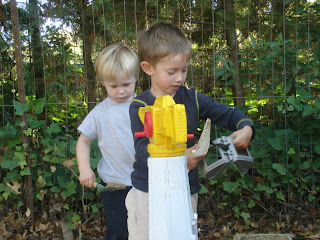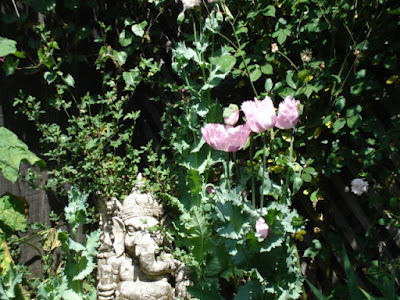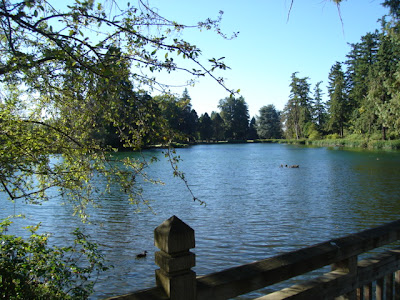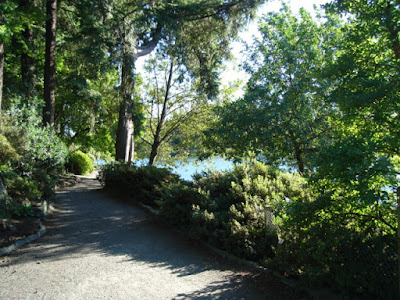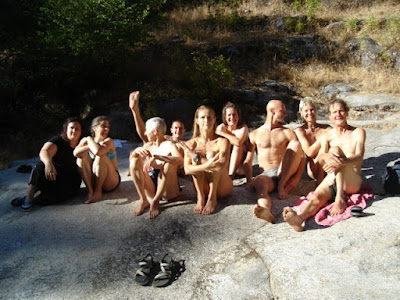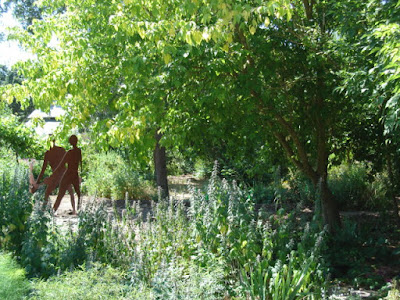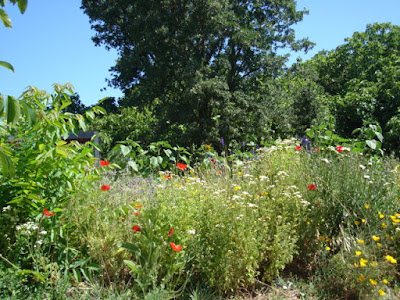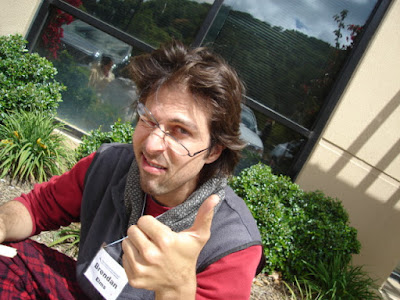A story Moshe told us in S.F., (yes, Eva, gossip!)is that when he was
at the Sorbonne, living nearby on the 'left bank' in a 5th floor
walk-up; on nights preceding lectures, he would read and study until
1:00 or 2:00 in the morning. Then, he would descend the back stairs
and under cover of darkness, he would mount his bicycle, pedal
furiously to his first 'assignation' which had been pre-arranged with
one of many lovely young ladies; most of his assignations involved
climbing up the back fire escape through the bedroom window,(nosy
landladies prevailed, and no doubt added to the illicit thrill!), have
sex for an hour or so, stealthily climb back down, pedal furiously to
the next 'assignation', and so on until first light, anywhere from 3
to 5 back stair or fire-ladder-climbing 'assignations'--a regular
pre-fixed route! until pre-dawn; then pedal home, maybe not so
furiously by then. He would sleep a few hours until late morning when
he would again mount his trusty bike and go for his cafe and
croissants at 'Deux Magots' and then pedal off to his afternoon round
of lectures and lab-work. In between lectures, he would go to the
'Bohemian' Cafe's: Café de la Paix, Les Deux Magots, Café de Flore,
for strong Turkish coffee and sundry sweets.
Then Moshe would go play soccer and/or practice Judo at his nearby
left bank Judokan he helped establish and then pedal home to perhaps
grab a 'cat nap', wake up and study and start the whole 'cycle' all
over again.
So, Silani, I am imagining those thunder thighs came from not only
soccer, but all of the above! What a man! These days it is rare that
a man has a physique to match his intellect and vice-versa!
I hasten to add that Moshe told this story of 'performing sex 4-5
times per day' on himself a bit shamefacedly, using himself as an
example of (then) male immaturity, admitting his "Don Juan" Complex,
and allowed that he was not proud of 'using women' in this
way--although still tinged with pride at his male sexual prowess. So
on the one hand, he talked about this as an example of 'mature
behaviour' NOT, positing that most men get 'just good enough' in their
sexual maturation, by copying their closest model, whether big
brother, father, uncle or adolescent peer, and are 'stuck' in their
adolescence vis-a-vis immature sexual behaviour. He made the point
that of all the animals, only humans have, for the most part,
neglected the developmental process of 'sexual apprenticeship'-- so
the act of sex is all trial and error rather than the high art it can
be of, say, Tantra.
On the other hand, he posited that men of power, John F,Kennedy,
great artists, Einstein, warriors, etc.--all are 'highly sexed' and
this 'comes with the territory' of male leadership--as we see with
Bill Clinton, and even so-called celibate Swami's and Guru's. He was
making the point that we should not be so shocked and scandalized at
such behaviour--it is part of male high personal achievement, and we
can't have one without the other!
In this day and age of PC, I don't know how this idea would go over in
a Feldenkrais training, but I still find it relevant and accurate,
whatever one makes of it, and helped me forgive Bill. And it still
epitomizes Moshe with all his personal paradoxes!
As a possibly redeeming foot note to my above gossip, here is another
tit-bit:
Cafe de la Paix is where it is (rumored!) that Moshe the student first
overheard and eavesdropped on Gurdjieff holding forth to his students
over said Turkish coffee and pastries. Such Cafe's allowed for such
pursuits; I can't quite imagine this level of conversation in a
Starbucks! It is probable that Gurdjeiff did not acknowledge MF's
keen attention, but spoke in a way that he could be 'overheard' from
his nearby table, where ostensibly he was reading his University
assignments.
It is (rumored!) that Moshe missed a few Sorbonne
lectures in favor of listening to Gurdjieff and learning about what
came to be called "The Fourth Way"-- this intriguing "new" psychology
of mind which was a melange of Sufism, other Eastern mysticism,
philosophy, psychology as then understood and being created by
Gurdjieff as different from Freud's "analysis" --which Moshe thought
got nobody anywhere except wallowing in past insults and injuries to
the psyche. He thought the most useful thing Freud discovered was "lie
on your back"!
Gurdjieff's philosophy was that man is asleep, and
needs to wake up! A philosophy of action, not analysis! Such thinking
to which every Feldy owes homage, imho. For a good article on the
Fourth Way, where you may see some similar concepts as espoused by
Moshe please see:
Duversity/GurdjieffI vouch not for the total veracity of my posting; yes, it is 'gossip',
but gossip Moshe told on himself, so at least has historical interest!
Of course he wrote at more length and more 'scientifically' on his
ideas about sexual maturation in Body and Mature Behaviour and the
Potent Self, which are as revelatory today about human nature as when
he wrote them.
All of the Zest,
Deborah Elizabeth Lotus







